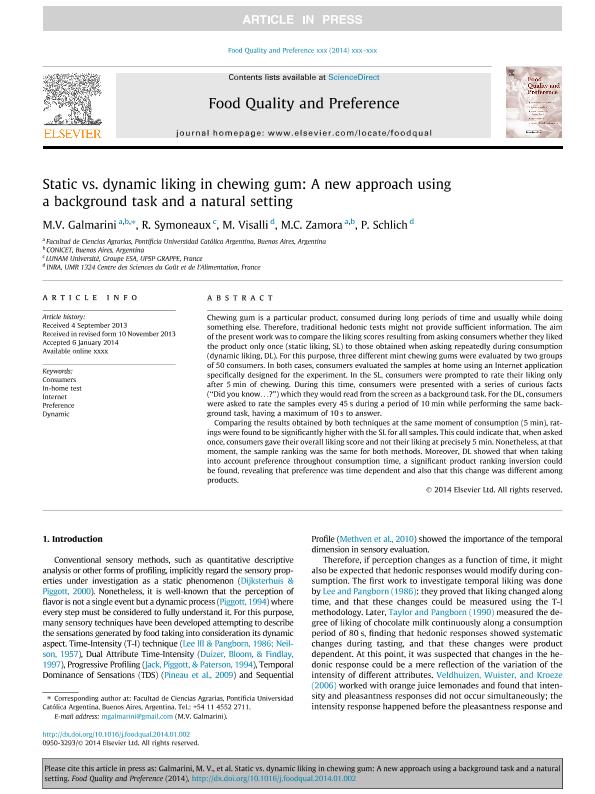Mostrar el registro sencillo del ítem
dc.contributor.author
Galmarini, Mara Virginia

dc.contributor.author
Symoneaux, R
dc.contributor.author
Visalli, M.
dc.contributor.author
Zamora, María Clara

dc.contributor.author
Schlich, P.
dc.date.available
2018-03-08T19:46:53Z
dc.date.issued
2015-03
dc.identifier.citation
Galmarini, Mara Virginia; Symoneaux, R; Visalli, M.; Zamora, María Clara; Schlich, P.; Static vs. dynamic liking in chewing gum: A new approach using a background task and a natural setting; Elsevier; Food Quality and Preference; 40; Part B; 3-2015; 381-386
dc.identifier.issn
0950-3293
dc.identifier.uri
http://hdl.handle.net/11336/38311
dc.description.abstract
Chewing gum is a particular product, consumed during long periods of time and usually while doing something else. Therefore, traditional hedonic tests might not provide sufficient information. The aim of the present work was to compare the liking scores resulting from asking consumers whether they liked the product only once (static liking, SL) to those obtained when asking repeatedly during consumption (dynamic liking, DL). For this purpose, three different mint chewing gums were evaluated by two groups of 50 consumers. In both cases, consumers evaluated the samples at home using an Internet application specifically designed for the experiment. In the SL, consumers were prompted to rate their liking only after 5 minutes of chewing. During this time, consumers were presented with a series of curious facts (?Did you know???) which they would read from the screen as a background task. For the DL, consumers were asked to rate the samples every 45 seconds during a period of 10 minutes while performing the same background task, having a maximum of 10 seconds to answer. Comparing the results obtained by both techniques at the same moment of consumption (5 min), ratings were found to be significantly higher with the SL for all samples. This could indicate that, when asked once, consumers gave their overall liking score and not their liking at precisely 5 minutes. Nonetheless, at that moment, the sample ranking was the same for both methods. Moreover, DL showed that when taking into account preference throughout consumption time, a significant product ranking inversion could be found, revealing that preference was time dependent and also that this change was different among products.
dc.format
application/pdf
dc.language.iso
eng
dc.publisher
Elsevier

dc.rights
info:eu-repo/semantics/openAccess
dc.rights.uri
https://creativecommons.org/licenses/by-nc-sa/2.5/ar/
dc.subject
Consumers
dc.subject
In-Home Test
dc.subject
Internet
dc.subject
Preference
dc.subject
Dynamic
dc.subject.classification
Alimentos y Bebidas

dc.subject.classification
Otras Ingenierías y Tecnologías

dc.subject.classification
INGENIERÍAS Y TECNOLOGÍAS

dc.title
Static vs. dynamic liking in chewing gum: A new approach using a background task and a natural setting
dc.type
info:eu-repo/semantics/article
dc.type
info:ar-repo/semantics/artículo
dc.type
info:eu-repo/semantics/publishedVersion
dc.date.updated
2018-03-08T19:00:13Z
dc.journal.volume
40
dc.journal.number
Part B
dc.journal.pagination
381-386
dc.journal.pais
Países Bajos

dc.journal.ciudad
Amsterdam
dc.description.fil
Fil: Galmarini, Mara Virginia. Pontificia Universidad Católica Argentina "Santa María de los Buenos Aires"; Argentina
dc.description.fil
Fil: Symoneaux, R. Lunam Université; Francia
dc.description.fil
Fil: Visalli, M.. Institut National de la Recherche Agronomique; Francia
dc.description.fil
Fil: Zamora, María Clara. Pontificia Universidad Católica Argentina "Santa María de los Buenos Aires"; Argentina. Consejo Nacional de Investigaciones Científicas y Técnicas; Argentina
dc.description.fil
Fil: Schlich, P.. Institut National de la Recherche Agronomique; Francia
dc.journal.title
Food Quality and Preference

dc.relation.alternativeid
info:eu-repo/semantics/altIdentifier/url/https://www.sciencedirect.com/science/article/pii/S0950329314000044
dc.relation.alternativeid
info:eu-repo/semantics/altIdentifier/doi/https://doi.org/10.1016/j.foodqual.2014.01.00210.1016/j.foodqual.2014.01.002
Archivos asociados
